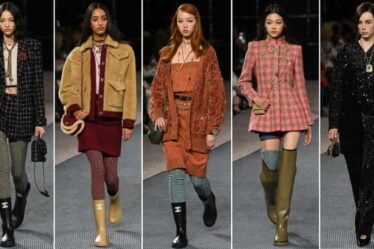
Meta will reportedly debut a prototype of its first-ever augmented-reality glasses Wednesday, but before that even happens, it may have already disrupted the eyewear market.
The new glasses — set to be unveiled at Meta’s annual Connect conference for developers — are expected to be capable of imposing a digital layer on the wearer’s physical surroundings. The catch is they aren’t planned to hit the market before 2027, according to a report last month by The Information. Similarly, Snap last week unveiled the latest generation of its AR Spectacles, but only developers who rent them for $99 a month will have access.
The unavailability of these products underscores how distant AR glasses and Mark Zuckerberg’s prophesied metaverse remain. In the meantime, another pair of AR-free Meta eyewear could prove as — or more — pivotal to the rise of smart glasses.
The Ray-Ban Meta glasses created in partnership with EssilorLuxottica have been a bigger hit than the companies themselves anticipated. In a July earnings call, Zuckerberg said demand continued outpacing their ability to build them. Market intelligence firm IDC estimates Meta has shipped more than 700,000 pairs, while Bernstein analyst Luca Solca surmised earlier this year that revenue from the glasses could approach $100 million in EssilorLuxottica’s 2024 fiscal year. Indicating their confidence in the future, Meta and EssilorLuxottica announced a long-term extension of their partnership last week.
The $299 glasses, which are widely available through select EssilorLuxottica retailers including LensCrafters and Sunglass Hut, as well as through the Ray-Ban and Meta websites, could be fairly deemed the first commercially successful smart glasses, marking a potential turning point for a category that the tech world has been trying — and failing — to popularise for more than a decade. If they are the start of a new era, it could signal upheaval for eyewear.
“Mainstream smart glasses are bound to be as disruptive as the rise of smartwatches — and the entry of Big Tech firms is likely to cause more pain than joy to incumbents,” Solca wrote in a June research note.
The product that sparked the turbulence in the watch market was the Apple Watch. It took time to gather momentum after its initial launch in 2015, years after the first rudimentary smartwatches first defined the category. But by 2019 Apple was estimated to be selling more units than the entire Swiss watch industry. It wasn’t until 2023 that Morgan Stanley decided the Apple Watch was no longer a threat to Swiss timepieces after the industry realigned around higher-end products.
Solca noted that there aren’t perfect parallels to be drawn between watches and eyewear, but the point stood that glasses are “destined to become the second major personal product category to be digitally disrupted,” largely because there remains need for a product that lets consumers access the internet while on the move. Phones are currently our preferred mobile device, but they occupy our hands and require our focus to the exclusion of our environment, which can be inconvenient or even dangerous at times. Glasses provide an ideal form for this new technology.
The key question is whether the Ray-Ban Meta glasses, which offer capabilities like high-quality audio and photography in classic Ray-Ban styles, are the equivalent of the Apple Watch in smart glasses.
Eyewear’s Big Disruptor?
“I don’t share the premise,” Solca wrote in an email. In his view, the Ray-Ban Meta glasses, while an “excellent approximation,” are still too limited in their abilities. When the disruptive new entrant does appear, it will likely have hundreds or thousands of apps available. He also expects AR will be key, combined with AI. “The revolution will come from aesthetically and culturally acceptable products with significant functionality,” he said. That could still be many years away.
There are a number of things the Ray-Ban Meta glasses already get right, according to owners who rave about them online.
“They are practical and they’re stylish,” said Michael Miraflor, chief brand officer at venture-capital firm Hannah Grey VC, who bought a pair earlier this year after reading reviews and seeing people wearing them at events. The glasses are a companion to his phone, not a replacement for it. He uses them frequently to take calls, pointing to the audio quality and saying he now reaches for them about half the time in situations where he would have previously defaulted to his Apple AirPods.
Others, meanwhile, have praised the glasses’ camera, which can be used to take photos, video or even to live stream directly to Instagram. Earlier this year, Meta also introduced multimodal AI features that allow the glasses to visually recognise objects and provide information on them. Miraflor said he wouldn’t rely on the AI for anything critical (and Wired detailed its struggles to translate languages). But it generally works in his experience, and he likes being able to get information on things like trees or landmarks while hiking around Los Angeles, without having to take out his phone.
“The core functionality of the device is pretty good,” he said. “It’s way better than just ‘good enough.’”
Maybe the most compelling feature, however, is that they just look like a pair of Ray-Bans.
Previous generations of smart glasses tended to have either minimal capabilities, or else they were bulky in order to house all the components needed to make them work. The first-generation Ray-Ban Stories managed to package everything into a regular-looking pair of sunglasses, but functionality was still limited.
The Ray-Ban Meta glasses have begun addressing both issues, with better audio, a better camera and AI — and more capabilities and frame options still likely to come in the future. It’s easy to imagine EssilorLuxottica extending the partnership to other brands in its portfolio, too.
But while the company looks to be setting itself up to be part of any disruption by smart glasses, its safety isn’t guaranteed. Solca pointed out that tech giants like Apple, which recently unveiled its first headset, could choose to enter the smart glasses category independently, knocking even incumbents like EssilorLuxottica off balance. The eyewear giant might be hedging against a scenario where it faces a Big Tech competitor on its own through its long-term deal with Meta.
In an emailed statement, Rocco Basilico, EssilorLuxottica’s chief wearables officer, said they’re leading the eyewear industry into the future through the deal. “Our Ray-Ban Meta smart glasses are a testament of creating a successful new category in eyewear and it’s only the beginning of where the partnership can go. Just as smart watches revolutionised the way we interact with technology, we see smart glasses as an opportunity to blend style with functionality thus creating more social acceptability.”
“Social acceptability” could prove difficult to ensure as companies try to enable AR. To fit the processors, sensors, displays and batteries — not to mention speakers if you want audio — requires a ludicrously capacious frame, Snap’s new AR glasses being an illustration of the challenge. (A former Snap design engineer who worked on the glasses called them “obviously bad.”)
Miraflor said he wouldn’t personally want AR capabilities at the expense of the look of the glasses. He’s bought other extended-reality devices in the past and has either returned them or left them collecting dust on a shelf. In fact, one thing he likes about the current iteration of the Ray-Ban Meta glasses is that they aren’t trying to do too much, keeping the Ray-Ban form factor intact and the glasses uncomplicated.
“If they shrink that AR functionality down to the point where they can hack all of that processing power into something that does look like a regular pair of sunglasses, then sure, I’ll try it out,” he said. “But I wouldn’t compromise the form factor to fit in something that is a bit more advanced that is not really that practical for day-to-day use.”



